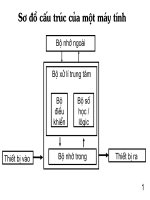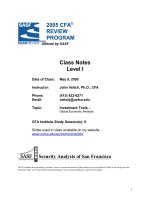CFA CFA level 3 CFA level 3 CFA level 3 CFA level 3 CFA level 3 CFA level 3 finquiz item set questions, study session 7, reading 18
Bạn đang xem bản rút gọn của tài liệu. Xem và tải ngay bản đầy đủ của tài liệu tại đây (125.69 KB, 4 trang )
Reading 18
Asset Allocation with Real-world Constraints
FinQuiz.com
FinQuiz.com
CFA Level III Item-set - Question
Study Session 9
June 2018
Copyright © 2010-2018. FinQuiz.com. All rights reserved. Copying, reproduction or
redistribution of this material is strictly prohibited.
FinQuiz.com © 2017 - All rights reserved.
Reading 18
Asset Allocation with Real-world Constraints
FinQuiz.com
FinQuiz Item-set ID: 134472
Questions 1(134473) through 6(134478) relate to Reading 18
Mark Reid Case Scenario
Mark Reid is an asset advisor at SouthWest Asset Management (SWAM). Reid is designing an
asset allocation for two defined benefit pension plan’s respectively operated by his clients, Joyce
Manufacturing (JM) and Regale Corporation (RC). He begins by collecting details on both
pension plans in Exhibit 1 below:
Exhibit 1: Defined Benefit Pension Plans
JM
Funding ratio
0.75
Equity allocation (%)
50
Fixed-income allocation (%): Corporate bonds
20
Alternative investments allocation (%)
30
Time horizon of plan liabilities
20 years
Average duration of bond assets
15 years
Total value of financial assets
$500 million
RC
1.00
80
20
0
15 years
16 years
$25 million
As part of his analysis, Reid also summarizes the investment objectives of the pension funds as
follows:
JM: To reduce surplus risk
RC: To minimize long-term future contributions, convert to an annuity plan, and maintain
portfolio volatility
Reid sits down with the RC’s chief financial officer to discuss the plan’s asset allocation. His
agenda is to focus on the following two items:
Item 1: Propose an allocation to alternative investments identical to JM. This will be achieved by
liquidating a portion of the equity allocation and re-investing the proceeds in alternative
investments.
Item 2: Consider the impact of taxes on the asset allocation (Exhibit 1) by analyzing a
breakdown of pre-tax returns and standard deviations (Exhibit 2) and correlations
(Exhibit 3).
Exhibit 2: Pre-tax Returns and Standard Deviations of RC’s Asset Allocation
Pre-tax
Pre-tax
Asset Class
Expected
Standard
Tax Rate
Return (%)
Deviation (%)
(%)
Investment grade (IG) corporate bonds
10
18
50
High yield (HY) corporate bonds
13
19
50
Equities
20
25
30
FinQuiz.com © 2017 - All rights reserved.
Reading 18
Asset Allocation with Real-world Constraints
FinQuiz.com
Exhibit 3:
Correlation Matrix for RC’s Asset Allocation
Asset Class
IG Bonds
HY Bonds
Equities
IG bonds
1.0
0.7
0.1
HY bonds
0.7
1.0
- 0.5
Equities
0.1
- 0.5
1.0
Based on his taxes and correlations analysis, Reid decides to place equities in a taxable account
and makes the following two conclusions:
Conclusion 1: Although IG and HY bonds are less tax-efficient, the addition of these two bonds
will bring risk reduction benefits to a taxable account.
Conclusion 2: While taxes serve to reduce the distribution of returns, the correlations between
any two asset classes are unaffected.
Next, Reid proceeds to set rebalancing ranges for a modified version of JM’s current asset
allocation which are presented in Exhibit 1. These ranges consider a proposed strategic asset
allocation (SAA) for the policy portfolio. The relevant data are presented in Exhibit 4.
Exhibit 4:
Rebalancing Ranges for a Modified Version of JM’s Policy Portfolio
Modified
Pre-tax
Asset Class
SAA
Current
Rebalancing
(%)
Allocation (%)
Range
Equities
50
43
±5%
Bonds
40
32
±10%
Alternative
10
25
±5%
investments
During Reid’s meeting with JM, the asset advisor discusses the results of his findings and the
rebalancing ranges for the three asset classes. Reid makes the following comments concerning
the rebalancing range for alternative investments:
Statement: “In response to a recent above average performance of alternative investments
securities, the rebalancing range has been widened to facilitate an overweighting of
the asset class to a higher policy limit.”
Lewis Strong, Reid’s subordinate, reviews the asset allocation pointing out that the advisor has
failed to consider the asset class’ past record of extreme volatility.
FinQuiz.com © 2017 - All rights reserved.
Reading 18
Asset Allocation with Real-world Constraints
FinQuiz.com
FinQuiz Question ID: 134473
1. Considering the asset allocation presented in Exhibit 1 and each client’s objectives, which of
the following statements is most likely correct? The asset allocation for:
A. JM carries a higher liquidity risk.
B. RC carries a higher contribution risk.
C. RC will result in a lower pension cost.
FinQuiz Question ID: 134474
2. In context of the meeting between Reid and the chief investment officer, which of the
following asset allocation constraints has Item 1 failed to consider?
A. Liquidity
B. Asset size
C. Time horizon
FinQuiz Question ID: 134475
3. With respect to his analysis of the impact of taxes on the asset allocation, Reid is most likely
correct regarding:
A. Conclusion 1 only.
B. Conclusion 2 only.
C. both of the conclusions.
FinQuiz Question ID: 134476
4. Using the data in Exhibit 2, the impact of taxes is lowest on the volatility of:
A. equities.
B. IG bonds.
C. HY bonds.
FinQuiz Question ID: 134477
5. Using the tax rates in Exhibits 2 and a 25% tax rate for alternative investments, which asset
class presented in Exhibit 4 requires rebalancing?
A. Bonds
B. Equities
C. Alternative investments
FinQuiz Question ID: 134478
6. In light of Lewis’ observation and Reid’s statements concerning the rebalancing range for
alternative investments, which of the following behavioral biases is the advisor subject to?
A. Availability
B. Illusion of control
C. Representativeness
FinQuiz.com © 2017 - All rights reserved.









